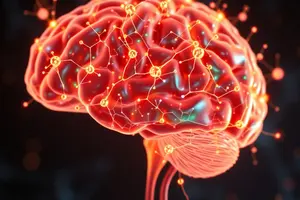Podcast
Questions and Answers
Which term refers to the brain's ability to change structurally and functionally following trauma?
Which term refers to the brain's ability to change structurally and functionally following trauma?
- Dormant synapses
- Neuronal unmasking
- Regenerative developments
- Plasticity (correct)
What did researchers discover about brain cells during their study of stroke victims in the 1960s?
What did researchers discover about brain cells during their study of stroke victims in the 1960s?
- Brain cells cannot be repaired after a stroke
- Brain cells remain unchanged after a stroke
- Brain cells re-wire themselves over time after a stroke (correct)
- Brain cells regenerate completely after a stroke
What did Wall (1977) identify as 'dormant synapses' in the brain?
What did Wall (1977) identify as 'dormant synapses' in the brain?
- Synaptic connections that are completely destroyed
- Synaptic connections that exist anatomically but their function is blocked (correct)
- Synaptic connections that are formed after a stroke
- Synaptic connections that are unaffected by trauma
Flashcards are hidden until you start studying
Study Notes
Neuroplasticity and Synaptic Function
- Neuroplasticity refers to the brain's ability to change structurally and functionally following trauma.
- In the 1960s, researchers discovered that brain cells can reorganize themselves after a stroke, leading to new connections and pathways.
- Wall (1977) identified 'dormant synapses' in the brain, which are inactive but can be activated to compensate for damaged areas.
Studying That Suits You
Use AI to generate personalized quizzes and flashcards to suit your learning preferences.




